- By Dan Veaner
- Around Town
 Print
Print 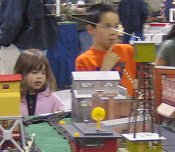 Everybody loves trains. There is something romantic about the old notion of riding the rails. And model railroads go way beyond being simply toys. Enthusiasts all over the world machine their own parts exactly to scale to make their trains historically authentic. Each year the trains come to Lansing when the Cornell Railroad Historical Society (CRHS) holds the annual Finger Lakes Railfair, the second largest rail show in New York State. "The show draws 1500 fans of railroading to get their yearly fix of fullsize railroadiana and models, kits and parts, videos, books, photos, and toys," says past club president John Marcham.
Everybody loves trains. There is something romantic about the old notion of riding the rails. And model railroads go way beyond being simply toys. Enthusiasts all over the world machine their own parts exactly to scale to make their trains historically authentic. Each year the trains come to Lansing when the Cornell Railroad Historical Society (CRHS) holds the annual Finger Lakes Railfair, the second largest rail show in New York State. "The show draws 1500 fans of railroading to get their yearly fix of fullsize railroadiana and models, kits and parts, videos, books, photos, and toys," says past club president John Marcham.The show took over both indoor fields at The FIELD, drawing exhibitors and vendors and plenty of enthusiasts. 7th grader Patrick Putnam came with his parents both days. His father Ken says he's loved trains since he was two or three years old, and that they have HO and O guage, and N guage layouts at home. Patrick dreams of attending a week-long class at Steamtown in Scranton, Pennsylvania, but has to wait another year to be olde enough to qualify. Club member Rich Moore says the club has sponsored other kids at the camp, and that one of them now works for a railroad. "I've wanted to be an engineer since I was ten," Patrick says, adding that he still hopes to get a job driving the big trains when he grows up.

Every imaginable scale of model was represented at the rail fair
CRHS displayed an enormous layout made of modules crafted by individual club members. The club owns the corners, and members make four and eight foot long modules representing a variety of locales that can be mixed and matched anywhere in the layout. Once assembled, trains could traverse the entire L-shaped layout, with their owners guiding them with controllers that plug into stations along the way.
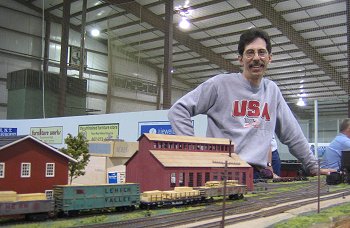
Steve Peck
Two impressive modules that depict lumber yards with detailed stacks of lumber and a turn of the century band saw mill belong to Steve Peck, AKA 'The Wood Doctor' in Trumansburg. Originally built by Norm Wilcox and restored and maintained by Peck, one is fashioned from brass, while the other is made of wood. Peck purchased them from Wilcox, promising to continue bringing them to club shows. The models were copied to make plastic model kits by Keystone Locomotive Works.
Peck says his interest had grown since he purchasd the modules and joined the club. He has begun crafting a reproduction of the Trumansburg Railroad Yards of 1947. "There were 18 buildings there, and I've got to build every one of them," Peck says. "There are no models like it."
The yard included a coal dump, a sauerkraut and pickle plant, and a grain mill. The model will be so authentic that Peck says he'll incorporate the smells of creosote, sauerkraut, grain and coal, as well as authentic sounds. He plans to have the finished module at the train show two years from now.

Art Wilcox with the layout he created
Andy Sowers, 15, helped work on his uncle's modules. Andy has been interested in trains since he was about three years old. The pair are especially interested in 40s through 60s era Lackawanna trains, and Andy says his uncle will be helping him build his own modules. "He'll help me with a model," Andy says. "This summer we're going to start working on two four foot modules for me to bring for the club layout."
Models on display included every size imaginable, from the tiny Z guage through N, HO and G. The Fingerlakes Live Steamers, Inc. even had authentic steam engine models large enough to ride on. Their club has maintained a 12 acre site in Morengo since 1969. Members bring their trains there to run on club tracks, and the club even has a machine shop for machining custom parts for their models.
The larger trains even run on authentic fuels. "They are real steam engines that burn either coal or fuel oil," says club member Vic Booth. "Your real ones ran coal in the east, because it was readily available. In the west they ran oil." Booth says the smaller models run on alcohol. The club hosts open houses twice a year. This summer they'll open to the public on June 23 and 24, and September 22 and 23, offering train rides, hamburgers and hotdogs, and souvenirs. Treaurer Tim Guenther says the club boasts about 130 members, ranging in age from 17 to 87.
Moore says that club members tend to fall into two general areas of interest. "There are people who like to model, to make something smaller, but as realistic as possible," he explains. "Then you have the rail fan who is really interested in the history of railroading, how it developed over time, and the current status of railroads. Most people I've met in the society have an interest in both areas, but maybe a strength in one or the other."
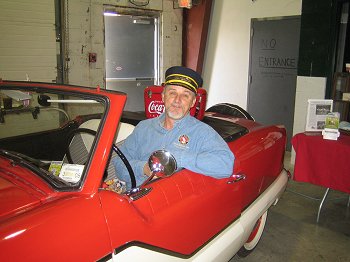
Tom Trencanski in his 1958 Nash Metropolitan
Tom Trencanski, who founded CRHS 25 years ago, has a passion for the real thing. He has photographed more than 20,000 slides, all of trains. "I've taken photographs all over the country," he says. "I've been to China to see the steam locomotives. I also volunteer at the Adirondack Scenic Railroad. So I stay active in the hobby."
Trencanski says that "Cornell" in the club name is deceiving, because most members are not from the university. "We have members from all over Tompkins County, from Boston, and the West Coast," Trencanski says. "The club is full of people from all walks of life. That's the good thing. We meet once a month, and we go to some of the train events together. It's a good hobby. It's a good club."
Trencanski brought a 1958 Nash Metropolitan, setting up his own drive-in movie with the show being a film about the Adirondack Scenic Railroad. The Metropolitan is the model of car that Noel Neill drove as Lois Lane on the 1950s Superman series with George Reeve. "It's my wife and my new baby," he says. "Our daughters grew up and we adopted this little Nash."
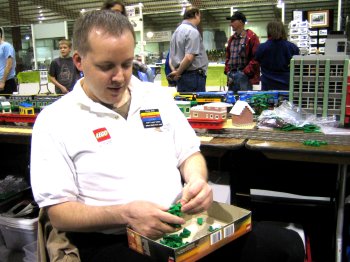
With a name tag made of LEGOs, Kevin Salm continuously
assembles more LEGOs while talking about the layout
One of the most popular exhibits for kids and adults alike was an impressive layout by the Lego Users of Central New York. LEGO trains traversed the display with freight containers sporting the logos of LEGO train clubs from around the world. Kevin Salm built many of the buildings in the display, and a core of enthusiasts brought their creations and manned the booth. Salm, who lives alone, recently bought an eight room house to hold his collection. While talking about LEGOs on Sunday he continuously assembled them. "I've been a Lego enthusiast all my life," he says. "By the time I was 12 years old that was the only toy I ever wanted."
Salm makes his living selling LEGO bricks on the Internet, and his stock dominates three of the rooms in his house. He buys current products, and stockpiles them for future sales. He sells to people of all kinds who need specific bricks for models they are building, including professionals," he says. "There are at least three or four people in the New York City area that build for hire. Some do it for supplementary income, but I know one who did it for his sole income. He went all over the country for trade shows, and commanded a high price for his work. He was very good."
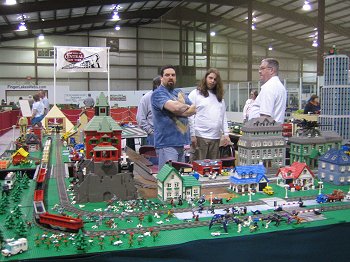
The LEGO layout
Salm was hit by a snow plow seven years ago, resulting in two broken legs and a broken hand. "Even when I had a broken hand I was still buying LEGO with the intention of building when I got my hand back. I never even thought about the possibility that I might not be able to any more. I just knew I would."
That kind of passion infuses the rail fair, whether it be exhibitors or visitors. A hands-on display was wildly popular with kids, who pressed buttons to make parts of the display come to life. "My brother David and I were examples of how local youngsters became hooked on trains early in life," Marcham says. In 1936, '37, and '38 we rode the Lehigh Valley gas-electric train from downtown Ithaca to Sheldrake on the west shore of Cayuga Lake."
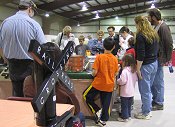
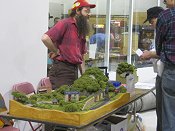
That started a life-long passion for Marcham, and obviously it is a passion shared by many people of all ages. Moore runs a model train along the roof line of a shed where customers pay for Christmas trees in November and December at his Lansing tree farm . Visitors at the rail fair were excited as they went from layout to layout. And many said they already look forward to next year's event.
----
v3i17



